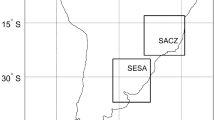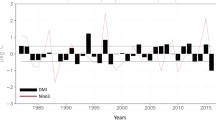Abstract
The relative impacts of the ENSO and Indian Ocean dipole (IOD) events on Indian summer (June–September) monsoon rainfall at sub-regional scales have been examined in this study. GISST datasets from 1958 to 1998, along with Willmott and Matsuura gridded rainfall data, all India summer monsoon rainfall data, and homogeneous and sub-regional Indian rainfall datasets were used. The spatial distribution of partial correlations between the IOD and summer rainfall over India indicates a significant impact on rainfall along the monsoon trough regions, parts of the southwest coastal regions of India, and also over Pakistan, Afghanistan, and Iran. ENSO events have a wider impact, although opposite in nature over the monsoon trough region to that of IOD events. The ENSO (IOD) index is negatively (positively) correlated (significant at the 95% confidence level from a two-tailed Student t-test) with summer monsoon rainfall over seven (four) of the eight homogeneous rainfall zones of India. During summer, ENSO events also cause drought over northern Sri Lanka, whereas the IOD events cause surplus rainfall in its south. On monthly scales, the ENSO and IOD events have significant impacts on many parts of India. In general, the magnitude of ENSO-related correlations is greater than those related to the IOD. The monthly-stratified IOD variability during each of the months from July to September has a significant impact on Indian summer monsoon rainfall variability over different parts of India, confirming that strong IOD events indeed affect the Indian summer monsoon.





Similar content being viewed by others
Notes
References
Ashok K, Guan Z, Yamagata T (2001) Impact of the Indian Ocean Dipole on the relationship between the Indian Monsoon rainfall and ENSO. Geophys Res Lett 28:4499–4502
Ashok K, Guan Z, Yamagata T (2003a) Influence of the Indian Ocean dipole on the Australian winter rainfall. Geophys Res Lett 30:1821, doi:10.1029/2003GL017926
Ashok K, Guan Z, Yamagata T (2003b) A look at the relationship between the ENSO and the Indian Ocean Dipole. J Meteor Soc Japan 81:41–56
Ashok K, Guan Z, Saji NH, Yamagata T (2004a) Individual and combined influences of the ENSO and Indian Ocean Dipole on the Indian summer monsoon. J Climate 17:3141–3155
Ashok K, Chan W-L, Motoi T, Yamagata T (2004b) Decadal variability of the Indian Ocean Dipole. Geophys Res Lett 31:L24207, doi:10.1029/2004GL021345
Behera SK, Krishnan R, Yamagata T (1999) Unusual ocean-atmosphere conditions in the tropical Indian Ocean during 1994. Geophys Res Lett 26:3001–3004
Bhaskar Rao DV, Ashok K, Yamagata T (2004) A numerical simulation study of the Indian summer monsoon of 1994 using NCAR MM5. J Meteor Soc Japan 82:1755–1775
Chang C-P, Harr P, Ju J (2001) Possible roles of Atlantic circulations on the weakening Indian monsoon rainfall-ENSO relationship. J Climate 14:2376–2380
Gadgil S, Vinayachandran PN, Francis PA (2003) Droughts of Indian summer monsoon: role of clouds over the Ocean. Curr Sci 85:1713–1719
Gadgil S, Vinayachandran PN, Francis PA, Gadgil S (2004) Extremes of the Indian summer monsoon rainfall, ENSO, and equatorial Indian Ocean oscillation. Geophys Res Lett 31:1821, doi:10.1029/2004GL019733
Gershunov A, Schneider N, Barnett T (2001) Low frequency modulation of the ENSO-monsoon rainfall relationship: signal or noise? J Climate 14:2486–2492
Guan Z, Ashok K, Yamagata T (2003) The summertime response of the tropical atmosphere to the Indian Ocean sea surface temperature anomalies. J Meteor Soc Japan 81:533–561
Kripalani RH, Kulkarni A (1999) Climatological impact of El Niño/La Niña on the Indian monsoon: a new perspective. Weather 52:39–46
Kripalani RH, Kumar P (2004) Northeast monsoon rainfall variability over south peninsular India vis-à-vis Indian Ocean Dipole mode. Int J Climatol 24:1267–1282
Kumar KK, Rajagopalan KB, Cane MA (1999) On the weakening relationship between the Indian monsoon and ENSO. Science 284:2156–2159
Lau N-C, Nath MJ (2004) Coupled GCM simulation of atmospheric-ocean variability associated with zonally asymmetric SST changes in the tropical Indian Ocean. J Climate 17:245–265
Legates DR, Willmott CJ (1990) Mean seasonal and spatial variability in gauge-corrected global precipitation. Int J Climatol 10:111–127
Li T, Wang B, Chang C-P, Zhang Y (2003) A theory for the Indian Ocean dipole-zonal mode. J Atmos Sci 60:2119–2135
Mooley DA, Parthasarathy B (1984) Fluctuations of all-India summer monsoon rainfall during 1871–1978. Climatic Change 6:287–301
Nicholls N (1989) Sea surface temperatures and Australian winter rainfall. J Climate 2:965–973
Nitta T, Yamada S (1989) Recent warming of tropical seas surface temperature and its relationship to the northern hemisphere circulation. J Meteorol Japan 67:375–383
Pant GB, Parthasarathy B (1981) Some aspects of an association between the southern oscillation and Indian summer monsoon. Arch Meteor Geophys BioKlimatol Ser B 29:245–251
Pant GB, Kumar RK (1997) Climates of South Asia. J. Wiley and Sons Ltd., England, 317 pp
Parthasarathy B, Kumar RK, Munot AA (1993) Homogeneous Indian monsoon rainfall: variability and prediction. Proc Ind Acad Sci 102:121–155
Parthasarathy B, Munot AA, Kothawale DR (1994) All-India monthly and seasonal rainfall series: 1871–1993. Theor Appl Climatol 49:217–224
Parthasarathy B, Munot AA, Kothawale DR (1995) Monthly and seasonal rainfall series for all-India homogeneous regions and meteorological subdivisions: 1871–1994. IITM research report No. RR-065, available from Indian Institute of Tropical Meteorology, Pashan, Pune-411 008, India
Parthasarathy B, Kumar RK, Munot AA (1996) Homogeneous regional summer monsoon rainfall over India: Interannual variability and teleconnections. IITM research report No. RR70, available from the Indian Institute of Tropical Meteorology, Pashan, Pune-411 008, India
Patra PK, Behera SK, Herman JR, Maksyutov S, Akimoto H, Yamagata T (2005) The Indian summer monsoon rainfall: interplay of coupled dynamics, radiation, and cloud microphysics. Atmos Chem Phys 5:2181–2188
Rayner NA et al (1996) Version 2.2 of the Global sea-Ice and Sea Surface Temperature Data Set, 1903–1994. Climate Research Technical Note 74. Hadley Centre for Climate Prediction and Research, Meteorological office, London Road, Bracknell, RG12 2SY
Rao AS, Behera SK, Masumoto Y, Yamagata T (2002) Interannual subsurface variability in the tropical Indian Ocean with a special emphasis on the Indian Ocean Dipole. Deep-Sea Res II 49:1549–1572
Raju PVS, Mohanty UC, Rao PLS, Bhatla R (2002) The contrasting features of Asian summer monsoon during surplus and deficient rainfall over India. Int J Climatol 22:1897–1914
Rasmusson EM, Carpenter TH (1983) The relationship between eastern equatorial Pacific sea surface temperatures and rainfall over India and Sri Lanka. Mon Wea Rev 111:517–528
Saji NH, Yamagata T (2003a) Possible impacts of Indian Ocean Dipole events on global climate. Climate Res 25:151–169
Saji NH, Yamagata T (2003b) Structure of SST and surface wind variability during Indian Ocean Dipole Mode events: COADS observations. J Climate 16:2735–2751
Saji NH, Goswami BN, Vinayachandran PN, Yamagata T (1999) A dipole mode in the tropical Indian Ocean. Nature 401:360–363
Sarkar S, Singh RP, Kafatos M (2004) Further evidences for weakening relationship of Indian rainfall and ENSO over India. Geophys Res Lett 31:L24207, doi:10.1029/2004GL020259
Sikka DR (1980) Some aspects of the large-scale fluctuations of summer monsoon rainfall over India in relation to fluctuations in planetary and regional scale circulation parameters. Proc Indian Acad Sci Earth Planet Sci 89:179–195
Slingo JM, Annamalai H (2000) 1997: The El Niño of the century and the response of the Indian summer monsoon. Mon Wea Rev 128:1778–1797
Tozuka T, Luo J-J, Masson S, Yamagata T (2007) Decadal modulations of the Indian Ocean dipole in the SINTEX-F1 coupled GCM. J Climate (in press)
Webster PJ et al (1998) Monsoons: processes, predictability and prospects for prediction. J Geophys Res 103:14451–14510
Webster PJ, Moore A, Loschnigg J, Leban M (1999) Coupled dynamics in the Indian Ocean during 1997–1998. Nature 401:356–360
Willmott CJ, Matsuura K (1995) Smart interpolation of annually averaged air temperature in the United States. J Appl Meteorol 34:2557–2586
Yamagata T, Behera SK, Rao SA, Guan Z, Ashok K, Saji HN (2003) Comments on “dipoles, temperature gradients, and tropical climate anomalies. Bull Amer Meteorol Soc 84:1418–1421
Yamagata T, Behera SK, Luo J-J, Masson S, Jury MR, Rao SA (2004) The coupled ocean-atmosphere variability in the tropical Indian Ocean. Earth’s climate: the ocean-atmosphere interaction. Geophys Monogr 147:189–211
Zubair LS, Rao A, Yamagata T (2003) Modulation of Sri Lankan Maha rainfall by the Indian Ocean Dipole. Geophys Res Lett 30(2):1063, doi:10.1029/2002GL015639
Acknowledgements
The subdivisional and homogeneous Indian rainfall sets were downloaded from http://www.tropmet.res.in, the IITM website. The figures in this paper were produced using COLA/GrADS software. The authors acknowledge Professor T. Yamagata and Drs S. K. Behera and Anguluri S. Rao for discussions.
Author information
Authors and Affiliations
Corresponding author
Rights and permissions
About this article
Cite this article
Ashok, K., Saji, N.H. On the impacts of ENSO and Indian Ocean dipole events on sub-regional Indian summer monsoon rainfall. Nat Hazards 42, 273–285 (2007). https://doi.org/10.1007/s11069-006-9091-0
Received:
Accepted:
Published:
Issue Date:
DOI: https://doi.org/10.1007/s11069-006-9091-0




